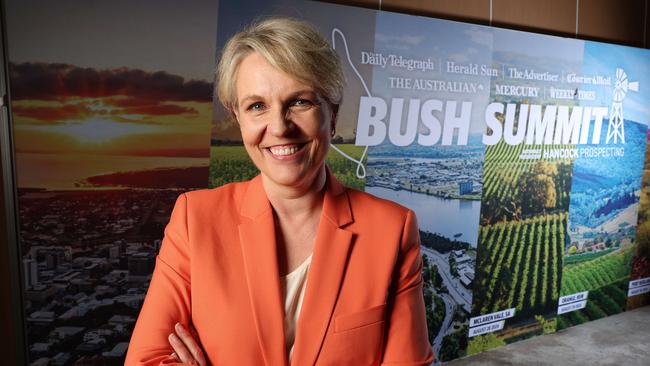Tanya Plibersek ‘must shed light on mine mystery’
Environment Minister Tanya Plibersek is under pressure to detail all the factors that swayed her controversial decision against a $1bn gold mine in NSW.

Environment Minister Tanya Plibersek is under pressure to detail all the factors that swayed her controversial decision against a $1bn gold mine in NSW, including claims by an Indigenous historian that the site was as significant as Gallipoli and the Somme because of the frontier wars fought by the local Wiradjuri people.
The Orange Local Aboriginal Land Council – which has cultural authority for the area under NSW law – did not object to the McPhillamys gold mine project and found after conducting its own surveys that it would not impact any sites of high significance. However, Ms Plibersek last week announced she was using the Aboriginal and Torres Strait Islander Cultural Heritage Act to excise the headwaters of the Belubula River from the proposed mine’s tailings dam, a decision that proponent Regis claims has killed the mine.
Ms Plibersek said she made the decision after listening to the small Bathurst-based Wiradyuri Traditional Owners Central West Aboriginal Corporation.
The Weekend Australian has been told that even Regis has not been told the reasons for the decision and has seen only a redacted summary of an export report that Ms Plibersek considered before her announcement. The author of the report is unknown to the proponent, which this week announced to the ASX that it had taken a $192m hit as a result of Ms Plibersek’s ruling.
Opposition environment spokesman John Duniam said the decision was a dangerous precedent for Australia’s environmental laws. “The Albanese government promised transparency and accountability. Now Tanya Plibersek needs to be more transparent about the advice that she received to reject this mine,” he said.
“The Environment Minister needs to clearly outline how a billion-dollar mine that has every state and federal environmental approval possible and the green light from the local Aboriginal land council, can be gutted at the last minute on reasons that we don’t have access to.
“How can companies have confidence to invest in our economy when projects like the McPhillamys gold mine can be knocked off for such secretive reasons at the last moment?”
One of the Wirudyuri corporation’s four directors, Lisa Paton, is a historian who previously worked for the Orange Aboriginal Land Council. She told an inquiry into the proposed mine last year: “This area is significant to my personal journey in discovering my Aboriginal Heritage.” The corporation has 18 members listed with the Office of Registrar of Indigenous Corporations. Most list only their first names.
Ms Paton wrote in her submission to the NSW Department of Planning, Industry and Environment that the site was of national significance “where numerous encounters between the Wiradjuri (including warrior Windradyne/Saturday) and European stockmen occurred in 1823”. She said this culminated in the Bathurst Wars in 1824, and eventually the proclamation of martial law in late 1824.
“It should be treated with the same respect as locations of other major historical battles such as Gallipoli and Battle of The Somme,” Ms Paton wrote.
Ms Plibersek acknowledged this week that she had listened to the Wiradyuri Traditional Owners Central West Aboriginal Corporation before making her decision, saying they were the people who had asked her to protect the headwaters and the springs of the Belubula River.
“They have told me that this area is significant to them. It has been significant for thousands of years. It is associated with the time that young people move into adulthood and a number of the creation stories of the Wiradjuri people,” she told the ABC.
So far Ms Plibersek has not explained if she gave weight to Ms Paton’s testimony that the area is as important as Gallipoli and the Somme because of its role in Australia’s frontier wars.
The legislation that allowed Ms Plibersek’s intervention – known as a section 10 declaration – is currently under review, a process started by the Coalition and continuing under Labor. On Friday Blayney mayor Scott Ferguson said: “Tanya wouldn’t tell us anything about the decision making.
“She said she had gone through more than 2500 documents, and also considered some verbal submissions. But she wouldn’t tell us anything about what was in them. She can hide behind the act, and that’s what’s infuriating people.”
“If there is an Aboriginal item of significant heritage there, then we would be so proud to have that in the Blayney shire. That would be great. I would want my community to be proud of it. But we have no idea what is going on.”
After The Australian revealed that a farm was in operation at the site and would be permitted to continue, Mr Ferguson said: “If you look at the act and Section 10, it says the land can only be used for traditional use.”



To join the conversation, please log in. Don't have an account? Register
Join the conversation, you are commenting as Logout